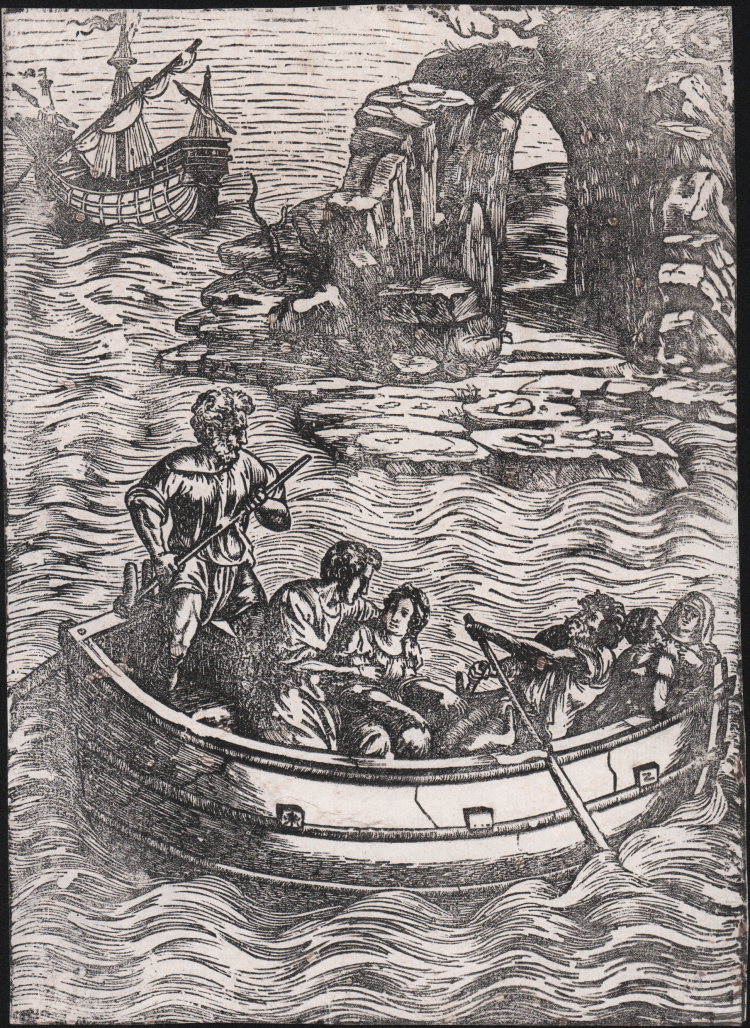- New




| Reference: | S50253 |
| Author | Gaspare Ruina |
| Year: | 1533 ca. |
| Measures: | 150 x 207 mm |



| Reference: | S50253 |
| Author | Gaspare Ruina |
| Year: | 1533 ca. |
| Measures: | 150 x 207 mm |
A rowboat in the foreground carrying several people, a man embraces a woman in the center, others row, in the background a large ship near an inlet.
Woodcut, ca. 1533/40, signed with floral monogram and distinguished by the number 2 on the side of the boat.
The print is part of a series of - probably - 9 episodes, with the subject not yet identified, but which seems to tell a mythological tale, with a female protagonist.
De Witt is thinking of a chivalric novel in the genre of Orlando Furioso. The series was first described precisely by De Witt (1934), who, on the basis of the monogram consisting of three arrows crossed with a ribbon, like the one that also appears in the print listed here, is to be referred to Gaspare Ruina. Compared to the corpus attributed to this engraver, the compositions, described by De Witt as 'illustrative,' seem better conceived and executed, both stylistically and technically. The invention has been referred by some to Girolamo de' Grandi, who also provided drawings for other compositions by the engraver. Venetian characters are noted that would suggest execution after the engraver moved to Venice, around 1533. The compositions denote takes from Agostino Veneziano, Dürer in the backgrounds, and the influence of Giulio Romano. According to Dodgson, the invention of these subjects dates back to Girolamo de' Grandi, around 1520, to whom other inventions later carved by Ruina are also traced.
Known specimens of the various plates in the series are few, but the condition of the impressions suggests that the woodcuts had a conspicuous issues: De Witt therefore speculates on the possibility that there existed an illustrated book with these compositions, which has remained unknown for now. Specimens of the compositions preserved in Hamburg (and Oxford, which De Witt did not know) show a better state of preservation of the wood.
Only three other specimens of this print are known to be preserved in London, British Museum (1860,0414,166); Trento, Museo Diocesano Tridentino (2 impressions); and Florence, Uffizi.
As evidenced by the London example of this subject, the proofs are derived from a very ruined woodblock
https://www.britishmuseum.org/collection/object/P_1860-0414-166
Bibliografia
De Witt A., "Un incisore ferrarese del '500", in Bollettino d'arte, 1934/1935, 3, Ser. 28, pp. 241-250, pp. 242-249, p. 242; Aldovini L., Atlante delle xilografie italiane del Rinascimento, ALU.0135.1.
https://archivi.cini.it/storiaarte/detail/9936/stampa-9936.html
Gaspare Ruina (attivo a Ferrara e Venezia tra il 1500 e il 1540)
|
Architect and woodcutter. Employed as an architect in Ferrara, and from 1533 in Venice. As a printmaker he worked predominantly after the designs of others; his most famous work being 'The Creation of Adam' after Michelangelo. This print was not however made in Rome, but was probably made in Ferrara after an intermediary drawing by Girolamo Grandi. Grandi is thought to be the draughtsman responsible for the majority of woodcuts by Ruina, including a series of nine (?) illustrating an unidentified Renaissance romance and a battle scene.
|
Gaspare Ruina (attivo a Ferrara e Venezia tra il 1500 e il 1540)
|
Architect and woodcutter. Employed as an architect in Ferrara, and from 1533 in Venice. As a printmaker he worked predominantly after the designs of others; his most famous work being 'The Creation of Adam' after Michelangelo. This print was not however made in Rome, but was probably made in Ferrara after an intermediary drawing by Girolamo Grandi. Grandi is thought to be the draughtsman responsible for the majority of woodcuts by Ruina, including a series of nine (?) illustrating an unidentified Renaissance romance and a battle scene.
|